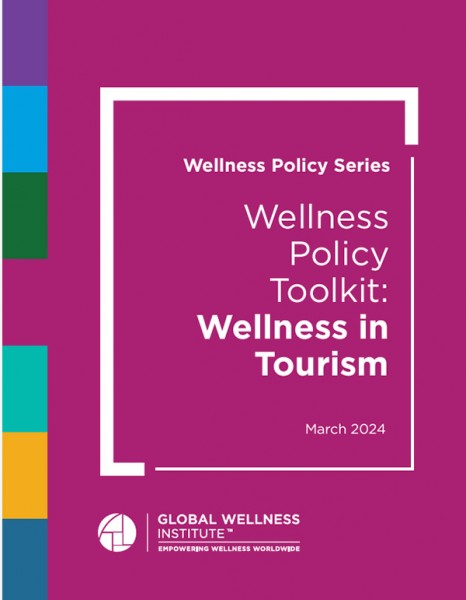Global Wellness Institute releases Wellness policy toolkit

The non-profit Global Wellness Institute has released a new Wellness Policy Toolkit which shifts the focus from Wellness Tourism to Wellness in Tourism.
The report – ‘Wellness Policy Toolkit: Wellness in Tourism’ presents policy ideas that move beyond the narrow goals of attracting luxury resorts and wealthy tourists to strategies that would bring more wellbeing to all—tourists, residents, and the destination.
The toolkit outlines numerous strategies that would enhance the quality of place for tourists, make tourism more successful and, at the same time, improve the wellbeing of both local residents and the destination. The report identifies six key barriers currently preventing wellness tourism from delivering those broader-based health and wellbeing benefits, and details six areas of policy action that could solve for those problems.
Ophelia Yeung, GWI senior research fellow notes “Wellness tourism does not exist in a vacuum and wellness travelers cannot be confined to a bubble.
“For those who want to succeed long-term in wellness tourism, it is only logical to focus more attention on the wellness of the place—including the local wellness infrastructure, the wellness of its people, and the destination.”
Who is this toolkit for?
It’s designed to help anyone interested in policy approaches that embed wellness broadly into tourism, placemaking, and local development. The strategies presented cut across wellness tourism, sustainable and responsible tourism, equitable wellness, quality of life, placemaking, and ‘placekeeping’.
The strategies can be pursued by those working in hospitality and tourism businesses, tourism promotion, destination management, economic development, or by those representing the wellbeing of workers and the community, and the protection of cultural heritage and the environment.
Six problems confronting wellness tourism, and policy actions that can tackle them:
The heart of the toolkit is laying out the key obstacles preventing wellness tourism from delivering broad-based health and wellbeing benefits to local destinations, residents and tourists. The report then outlines a wide array of policy actions that can address each issue.
Problem: Many businesses, governments, communities and travellers have a very narrow understanding of wellness tourism and its potential.
Policy actions that expand the reach and impact of wellness tourism.
Problem: Wellness tourism offerings are often siloed and separated from local consumers, businesses and communities.
Policy actions that integrate the local economy with the wellness tourism economy.
Problem: The people working to improve the wellness of others are not well themselves.
Policy actions that improve the wellness of the tourism workforce.
Problem: Destinations and local communities are often the collateral damage of the tourism economy, including wellness tourism.
Policy actions that embed equity and sustainability in wellness tourism development and stewardship.
Problem: Rapidly evolving wellness sectors challenge governments and policies to keep up.
Policy actions that support wellness tourism with up-to-date wellness market knowledge and regulations.
Problem: Technology is pervasive in tourism, but it does not always enhance the wellness or experiences of tourists.
Policy actions that ensure that technology enhances wellbeing for travellers.
New datasets on the wellness tourism market:
To put the opportunity in context, the GWI has also released a first-ever time-series dataset on the wellness tourism market (from 2012 to 2022, and projecting forward to 2027). This compilation of 15 years of data provides a clear snapshot of wellness tourism’s explosive growth and how it’s a powerful, enduring travel trend that will continue to reshape the tourism industry.
The dataset provides a clear historical view of global wellness tourism revenue growth: surging from $439 billion in 2012 to $651 billion in 2022—and expected to more than double by 2027, to $1.4 trillion. It spotlights the growth in wellness trips worldwide: from 524 million in 2012 to 819 million in 2022, and expected to reach 1.63 trillion by 2027. It compares wellness tourism growth rates to overall tourism growth: pre-pandemic, during the pandemic, in the pandemic recovery years, and with a future projection through 2027. It shows how wellness tourism trips make up an ever-growing percentage of all tourism trips: expanding from 5.8% in 2012 to 7.75% in 2022, and expected to reach 8.3% by 2027. And, finally, it lays out the shifting spending premiums for both domestic and international wellness tourists over the last decade.
DOWNLOAD the full (free) report here.
Related Articles
21st March 2024 - Global Wellness Institute appoints Aradhana Khowala to its Board of Advisors
18th February 2024 - Global Wellness Institute partners with Therme Group to showcase South Korea’s wellness offerings
31st January 2024 - Global Wellness Institute ranks Australia 11th of 145 countries based on wellness market size
1st December 2023 - Global Wellness Institute forecasts wellness tourism to reach US$1 trillion in 2024
1st September 2023 - Global Wellness Institute spotlights Japan’s Wellness Economy
12th September 2022 - Global Wellness Institute spotlights Thailand’s Wellness Industry assets
26th May 2022 - Global Wellness Institute launches country-specific Geography of Wellness microsite
24th June 2021 - Global Wellness Institute spotlights public art and wellness trend
27th May 2021 - Global Wellness Institute predicts more sophisticated medical wellness destinations
6th May 2021 - Global Wellness Institute highlights rise of the ‘Nature Economy’
11th November 2020 - Global Wellness Institute reports mental wellness to be a $121 billion market
8th October 2020 - Global Wellness Institute reports Asia-Pacific having largest economic growth in fitness, sport and recreation sectors






